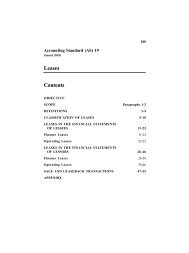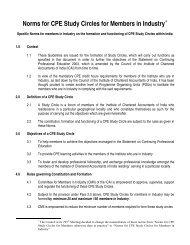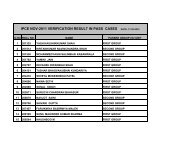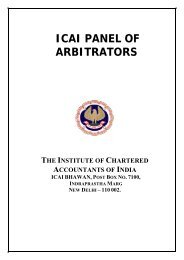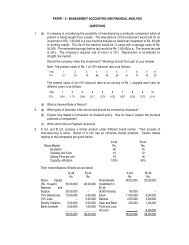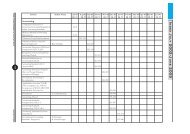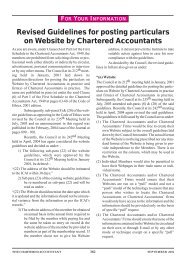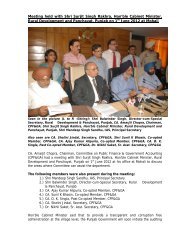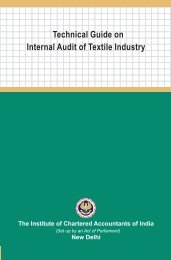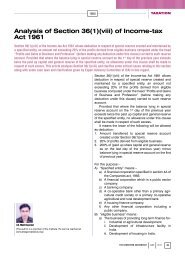The Chartered Accountant
The Chartered Accountant
The Chartered Accountant
You also want an ePaper? Increase the reach of your titles
YUMPU automatically turns print PDFs into web optimized ePapers that Google loves.
m Integrity and thical values<br />
m Commitment to competence<br />
m Board of Directors or Audit<br />
Committee<br />
m Organizational Structure<br />
m Human Resource Policies<br />
and Practices<br />
b. “control activities” (or procedures)<br />
which means those policies<br />
and procedures in addition<br />
to the control environment<br />
which management has established<br />
to achieve the entity’s<br />
specific objectives. Control<br />
activities include approvals,<br />
authorizations, verifications,<br />
reconciliations, reviews of<br />
performance, security of assets,<br />
segregation of duties, and<br />
controls over information systems.<br />
4. Internal controls may be either<br />
preventive or detective. Preventive<br />
controls attempt to deter or prevent<br />
undesirable acts from occurring. <strong>The</strong>y<br />
are proactive controls that help to<br />
prevent a loss. Examples of preventive<br />
controls are separation of duties,<br />
proper authorization, adequate documentation,<br />
and physical control over<br />
assets. Detective controls attempt to<br />
detect undesirable acts. <strong>The</strong>y provide<br />
evidence that a loss has occurred but<br />
do not prevent a loss from occurring.<br />
Examples of detective controls are<br />
reviews, analyses, variance analyses,<br />
reconciliations, physical inventories,<br />
and audits.<br />
5. Internal controls are generally<br />
concerned with achieving the following<br />
objectives:<br />
q Transactions are executed in<br />
accordance with management’s<br />
general or specific authorisation.<br />
q All transactions and other<br />
events are promptly recorded<br />
in the correct amount, in the<br />
appropriate accounts and in the<br />
proper accounting period so as<br />
EXPOSURE DRAFTS<br />
to permit preparation of financial<br />
statements in accordance<br />
with the applicable accounting<br />
standards, other recognised accounting<br />
policies and practices<br />
and relevant statutory requirements,<br />
if any, and to maintain<br />
accountability for assets.<br />
q Assets and records are safeguarded<br />
from unauthorised access,<br />
use or disposition.<br />
q Recorded assets are compared<br />
with the existing assets at reasonable<br />
intervals and appropriate<br />
action is taken with regard<br />
to any differences.<br />
q Systems and procedures are<br />
effective in design and operation.<br />
q Risks are mitigated to a reasonable<br />
extent.<br />
6. Internal Control is a process. Internal<br />
control can be expected to provide<br />
only reasonable assurance, not<br />
absolute assurance. Internal control<br />
is geared to the achievement of objectives.<br />
Internal control is effected<br />
by people and not by policy manuals<br />
and forms alone.<br />
Inherent Limitations of Internal<br />
Controls<br />
7. Internal control systems are<br />
subject to some inherent limitations,<br />
such as:<br />
q Management’s consideration<br />
that the cost of an internal<br />
control does not exceed the expected<br />
benefits to be derived.<br />
q <strong>The</strong> fact that most internal<br />
controls do not tend to be directed<br />
at transactions of unusual<br />
nature.<br />
q <strong>The</strong> potential for human error,<br />
such as, due to carelessness,<br />
distraction, mistakes of judgement<br />
and the misunderstanding<br />
of instructions.<br />
q <strong>The</strong> possibility of circumvention<br />
of internal controls<br />
through the collusion with em-<br />
ployees or with parties outside<br />
the entity.<br />
q <strong>The</strong> possibility that a person<br />
responsible for exercising an<br />
internal control could abuse<br />
that responsibility, for example,<br />
a member of management<br />
overriding an internal control.<br />
q Manipulations by management<br />
with respect to transactions<br />
or estimates and judgements<br />
required in the preparation of<br />
financial statements.<br />
Role of the Internal Auditor<br />
in Evaluating Internal Controls<br />
8. <strong>The</strong> Internal auditor should<br />
examine and contribute to the ongoing<br />
effectiveness of the internal<br />
control system through evaluation<br />
and recommendations. However,<br />
the internal auditor is not vested<br />
with management’s primary responsibility<br />
for designing, implementing,<br />
maintaining and documenting internal<br />
control. Internal audit functions<br />
add value to an organization’s<br />
internal control system by bringing<br />
a systematic, disciplined approach to<br />
the evaluation of risk and by making<br />
recommendations to strengthen<br />
the effectiveness of risk management<br />
efforts. <strong>The</strong> internal auditor<br />
should focus towards improving<br />
the internal control structure and<br />
promoting better corporate governance.<br />
<strong>The</strong> role of the internal auditor<br />
encompasses:<br />
q Evaluation of the efficiency<br />
and effectiveness of controls;<br />
q Recommending new controls<br />
where needed – or discontinuing<br />
unnecessary controls;<br />
q Using control frameworks;<br />
q Developing Control self-assessment.<br />
9. <strong>The</strong> internal auditor’s evaluation<br />
of internal control implies:<br />
q determining the significance<br />
and the sensitivity of the risk<br />
THE CHARTERED ACCOUNTANT 1113 DECEMBER 2008



